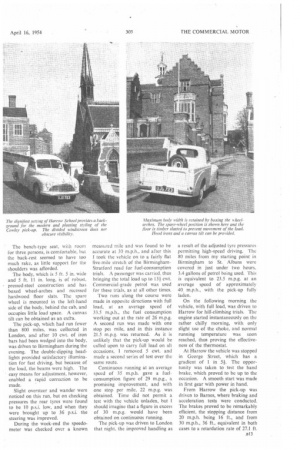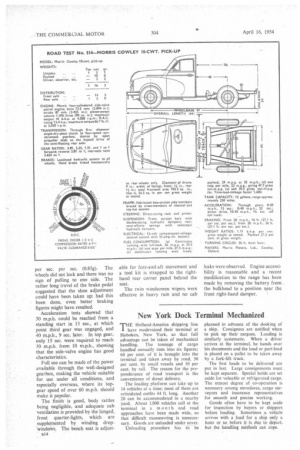By John F. Moon
Page 46

Page 47

Page 48

If you've noticed an error in this article please click here to report it so we can fix it.
A Handy Vehicle for Small Loa
Morris 1O-cwt. Pick-up Performs Well on Test and has Adequate Body Space: Lively Acceleration and Good Braking
WITH a load of 10 cwt. and one passenger, the Morris Cowley pick-up was well out m front in the post-traffic-light rushes so typical of London traffic, and braking was well up to emergency stops. On town or trunk roads, the pick-up was equally at home and the comfortable cab, handy controls and positive steering made driving a pleasure.
Fuel-consumption tests were made
on a busy main road in the Midlands, the rather heavy traffic-not conducing to the best results, but the figures obtained were not unreasonable. On a long run at a fairly high average speed a fuel-consumption rate of 23.5 m.p.g. was returned, but full use was made of the throttle pedal, and such a figure could most probably be improved upon with more restrained driving.
The li-litre side-valve engine, which develops 41 b.h.p. at 4,000 np.m. and is similar to the unit used in the Morris Oxford car, provides ample power for a 10-cwt. load. The cylinder block and crankcase are an iron casting. The three-bearing crankshaft has steel-backed, whitemetal bearings, as have the connecting-rod big-ends, and the three n12 bearing camshaft is driven from the crankshaft by helical gears.
An air cleaner is fitted to the single S.U. carburetter. A centrifugal impeller is incorporated in the pressurized cooling system and circulation is thermostatically controlled.
The steering-column control for the four-speed synchromesh gearbox is positive and light in operation and I found the choice of ratios ideal for most hill and town work. A short propeller shaft transmits the drive to the semi-floating rear axle, which has hypoid drive of a lower ratio than that fitted to the car.
Steering is by direct-acting rack and pinion, and although a trifle heavy at low speeds, especially when no load is carried, it is not tiring on a long journey. • I would have preferred a steering wheel of slightly larger diameter, or at least one having a thicker rim.
The independent front suspension is effective on all road surfaces, but a slight drumming was perceptible in the cab on granite setts; no reaction was felt at the steering wheel.
The cab is well up to car standards. Indeed, the only refinements missing are a clock, heater and traffic indica tors. Provision, however, is made for fitting a clock and heater. The full-width shelf beneath the dash panel is useful, and the wide, forward-opening doors make for easy entry and exit. The bench-type seat, with room for three persons, is comfortable, but the back-rest seemed to have too much rake, as little support for the shoulders was afforded.
The body, which is 5 ft. 5 in. wide and 5 ft. 11 in. long, is of robust. pressed-steel construction and has boxed wheel-arches and recessed hardwood floor slats. The spare wheel is mounted in the left-hand side of the body, behind the cab, and occupies little load space. A canvas tilt can be obtained as an extta.
The pick-up, which had run fewer than 800 miles, was collected in London, and after 10 cwt. of iron bars had been wedged into the body, was drIven to Birmingham during the evening. The double-dipping headlights provided satisfactory illumination for fast driving, but because, of the load, the beams were high. The easy means for adjustment, however, enabled a rapid correction to be made.
Slight oversteer and wander were noticed on this run, but on checking pressures the rear tyres were found to be 10 psi. low, and when they were brought up to 36 p.s.i. the steering was improved.
During the week-end the speedometer was checked over a known measured mile and was found to be accurate at 30 m.p.h., and after this I took the vehicle on to a fairly flat five-mile stretch of the BirminghamStratford road for fuel-consumption trials. A passenger was carried, thus bringing the total load up to 13i cwt. Commercial-grade petrol was used for these trials, as at all other times.
Two runs along the course were made in opposite directions with full load, at an average speed of 333 m.p.h., the fuel consumption working out at the rate of 26 m.p.g. A second run was made with one stop pet mile, and in this instance 21.5 m.p.g. was returned. As it is unlikely that the pick-up would be called upon to carry full load on all occasions, I removed 5 cwt. and made a second series of test over the same route.
Continuous running at an average speed of 35 m.p.h. gave a fuelconsumption figure of 29 m.p.g., a promising improvement, and with one stop per mile, 22 m.p.g. was obtained. Time did not permit a test with the vehicle unladen, but I should imagine that a figure in excess of 30 m.p.g. would have been obtained on continuous running.
The pick-up was driven to London that night, the improved handling as a result of the adjusted tyre pressures permitting high-speed driving. The 80 miles from my starting point in Birmingham to St.. Albans were covered in just under two hours. 3.4 gallons of petrol being used. This is equivalent to 23.5 m.p.g. at an average speed of approximately 40. m.p.h., with the pick-up fully laden.
On the following morning the vehicle, with full load, was driven to Harrow for hill-climbing trials. The engine started instantaneously on the rather chilly morning, with only slight use of the choke, and normal running temperature was soon reached, thus proving the effectiveness of the thermostat.
At Harrow the vehicle was stopped in George Street, which has a gradient of 1 in 5. The opportunity was taken to test the hand brake, which proved to be up to the occasion. A smooth start was made in first gear with power in hand.
From Harrow the pick-up was driven to Barnes, where braking and acceleration tests were conducted. The brakes proved to be remarkably efficient, the stopping distance from 20 m.p.h. being 16 ft., and from 30 m.p.h., 36 ft, equivalent in both cases to a retardation rate of 27.1 ft. per sec. per sec. (0.85g). The wheels did not lock and there was no sign of pulling to one side. The rather long travel of the brake pedal suggested that the shoe adjustment could have been taken up: had this been done, even better braking figures might have resulted.
Acceleration tests showed that 30 m.p.h. could be reached from a standing start in 13 sec., at which point third gear was engaged, and 40 m.p.h., 9 sec. later. In top gear, only 15 sec. were required to reach 30 m.p.h. from 10 m.p.h., showing that the side-valve engine has good characteristics.
Full use can be made of the Power available through the well-designed gearbox, making the vehicle suitable for use under all conditions, and especially overseas, where its topgear speed of over 60 m.p.h. should make it popular.
The finish is good, body rattles being negligible, and adequate cab ventilation is provided by the hinged, front quarter-lights, which are supplemented by winding dropwindows. The bench seat is adjust able for fore-and-aft movement and a tool kit is strapped to the righthand rear corner panel behind the seat.
The twin windscreen wipers were effective in heavy rain and no cab
leaks were observed. Engine accessibility is reasonable and a recent modification to the range has been made by removing the battery from the bulkhead to a position near the front right-hand damper.




















































































